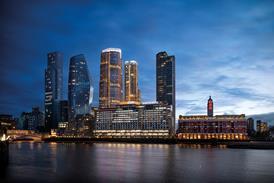
Thomas Lane
Responsible for the projects section which covers architecture and technical. This includes regulations, sustainability, innovation and best practice. Thomas also looks after the economics section of the magazine.
Contact info
- Tel:
- 020 3011 3132
- Email:
- thomas.lane@assemblemediagroup.co.uk
 Comment
CommentIs it time to stop building in the wildfire affected areas of California?
The recent fires in the hills around Los Angeles are the most costly in US history. Does it really make sense to live in these heavily wooded places?
 Features
FeaturesMaterial passports: the key to carbon reduction, greater component reuse and more sustainable construction
Logging the details of the products and materials used on projects so they can have a second life after demolition has been discussed but never practised on a large London construction project – until now, Thomas Lane reports
 Features
FeaturesThe Elephant reborn: How Multiplex is rebuilding a south London landmark
The crumbling Elephant and Castle shopping centre built in the 1960s is being reinvented as a mixed-use destination as part of Southwark council’s strategy to regenerate the area. Thomas Lane visits to see how it is coming along
 Features
FeaturesHow a Victorian hospital became a forward-focused university department
When the Royal Infirmary of Edinburgh moved to a new site on the edge of the city, the old hospital was left to rot because of its uncompromising layout. Two decades later it has been reinvented as the Edinburgh Futures Institute, an educational initative which seeks to help solve the ...
 Comment
CommentThe net zero carbon buildings standard: tough but achievable?
The new standard is the most ambitious attempt to limit carbon emissions from buildings to date. What is behind it, and when will it start to make a difference?
 Features
FeaturesSpace House: 1960s icon gets another chance to shine
Centrepoint’s little sister was realised by the same architect and developer and built with similar pioneering techniques. Neglected for the past four decades, a recent refurbishment restores and celebrates the building’s groundbreaking architectural qualities
 Features
FeaturesPicking up Carillion’s pieces: how Balfour Beatty finally finished the Midland Metropolitan University Hospital
West Birmingham’s new super hospital has just opened, six years later than planned following the failure of Carillion in 2018. Thomas Lane visits the new building to find out how the team overcame multiple problems, and to see what the finished project is like
 Features
FeaturesHinkley Point C: ����Ӱ�� Britain’s first nuclear reactor in 30 years
Like its Finnish and French twins, Hinkley Point C has suffered from cost overuns and delays. What are the team doing to claw back the losses and what does this mean for Sizewell C?
 Features
FeaturesThe Tribeca brick: Made from earth and water but (crucially) no fire
London’s largest life sciences project is trialling the use of a low carbon earth brick for the basement walls of the first phase. It could be a game-changer for schemes looking to radically reduce their carbon footprint. Thomas Lane reports
 Features
FeaturesHow do you fix a grade I listed Oxford college built from RAAC?
All the roofs at St Catherine’s College were recently condemned thanks to the presence of RAAC. Thomas Lane reports on how the team came up with a solution that didn’t affect the historical significance of the Arne Jacobsen-designed campus
 Comment
CommentWill Labour’s proposed planning changes help to deliver more homes?
This week has been dominated by housing policy including a new towns task force and proposals to build more homes in more places including the green belt. Thomas Lane assesses what implications the proposals may have for new housing supply
 Features
FeaturesBritish Land’s resurrection of Norton Folgate
Blossom Street was the focus of a vitriolic planning battle. But British Land has confounded the fears of Spitalfields residents by sensitively restoring many of the old buildings
 Features
FeaturesThe making of Egham: how to pull a town centre up by its bootstraps
Allford Hall Monaghan Morris and Runnymede council have delivered a mixed-use scheme that aims to reverse the slow decline of this busy Surrey town. Thomas Lane reports
 Features
FeaturesLearning on the job: how Wales is leading the way with net zero schools
The Vale of Glamorgan council and ISG have spent the past 10 years refining and monitoring their standardised school solution and have now gone from gas guzzlers to carbon negative, Thomas Lane reports
 Features
FeaturesIt’s M&S’s Oxford Street neighbour – and it’s being refurbished, not demolished
The former House of Fraser store is just half a mile from the M&S flagship which the retailer controversially wants to knock down and rebuild. Thomas Lane meets the team to find out how they are making the refurbishment work
 Features
FeaturesWhy the industry needs another net zero carbon buildings standard
David Partridge has been tasked with bringing together construction’s many and varied definitions of net zero. He tells Thomas Lane why setting a recognised and easily understood benchmark for whole-life carbon emissions is so important
 Features
FeaturesFashion statement … London college becomes first to make its new home on the waterfront
The London College of Fashion has brought its six separate sites under one roof for the first time in more than 100 years. Tom Lane reports
 Features
FeaturesHow digital twins are cutting carbon emissions for the Ministry of Justice
Digital twins have the potential to operate buildings more efficiently than traditional facilities management systems. The MoJ is trialling the technology at its Five Wells prison and the early indications are looking good
 ����Ӱ��
����Ӱ��Cat A fitouts are two and a half times more carbon intensive than previously thought, research reveals
The study, carried out by AHMM, challenges the assumptions made in the RICS Whole Life Carbon Assessment which has become the industry standard for calculating carbon emissions
 Comment
CommentTo retain or rebuild? M&S case shows the industry needs rules
The High Court ruling overturning Michael Gove’s decision to deny M&S permission to redevelop its Oxford Street store shows that a framework setting out the conditions for redevelopment is urgently needed




















